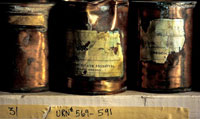Cut Your Documentary Until It Bleeds
I recently heard a PBS producer use the phrase “cut until it bleeds” to refer to the often painful post-production process. If you’re editing a documentary, chances are you’ve already begun cutting out some treasured sound bites and scenes. Good for you. In my opinion, ninety percent of documentaries that make it to a film festival could use another 10-15 percent of the footage cut out.
That’s why I was so pleased when our story-consulting client Robert James showed me his completed short, “Library of Dust”. At 14 minutes, this compelling documentary short manages to intercut at least five storylines and more than twenty interviews. The result was a rich viewing experience for the audience—and for James and his co-producer Ondi Timoner, a prestigious award. The film won the “Best Documentary Short Film” at the Seattle International Film Festival two weeks ago.
To ensure that your documentary enthralls audiences with a tightly-structured pace, keep in mind these three tips while editing:
1. Weed out all repetition. If two interviewees make the same point, you get to keep one of the sound bites. Which is more eloquent, emotional and succinct? Strike the other. And if you’ve already made a point in your narration, don’t repeat the same idea in a sound bite.
2. Apply the “need-to-know test”. In terms of exposition, does the viewer need to know this particularly information to make sense of the story? In terms of plot lines, does the additional plot or subplot somehow enhance the original storyline? As screenwriting guru Robert McKee points out, subplots must earn their keep in the film, often as a mirror or foil to the main plot.
3. Use narration. One of the chief jobs of narration is to do the heavy lifting of establishing your film’s setting and storytelling. Well-crafted narration can make a point in one sentence that takes your interviewee 3-4 sentences. Cut those interviews until you bleed.
For a free, quality tutorial on how to write great documentary narration, check out our recent teleseminar at:
https://newdocediting.com/teleseminars/PersonableDocNar.wav
It’s jam-packed with tips for writing compelling narration.
So, my fellow filmmakers, take another pass at cutting, and if your second rough cut feels like a bloody mess, you’re probably on the right track. Ask yourself, are the essential plot points still there? Does my film still make sense?
If the answer is yes, congratulations. If the answer is no, don’t worry. It’s quite common to overcut, and you simply need to identify the missing idea, scene or character and add them back in.
As you make your way through post-production, focus increasingly on the viewer, not the original vision of an auteur. Remember, the right question is not, “How do I get all this precious footage (and all these great ideas) into a feature-length film?” It’s “How can I provide a compelling viewing experience for the audience, while informing and inspiring them at the same time?”
